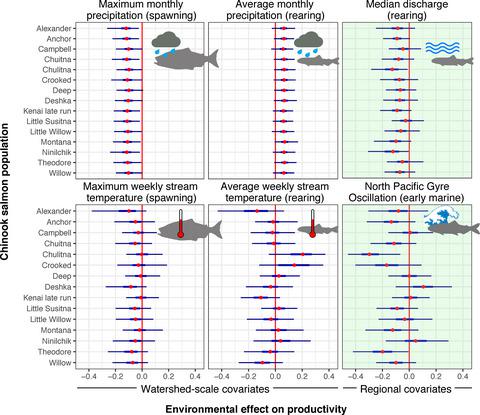当前位置:
X-MOL 学术
›
Glob. Change Biol.
›
论文详情
Our official English website, www.x-mol.net, welcomes your
feedback! (Note: you will need to create a separate account there.)
Watershed-scale climate influences productivity of Chinook salmon populations across southcentral Alaska.
Global Change Biology ( IF 10.8 ) Pub Date : 2020-07-06 , DOI: 10.1111/gcb.15155 Leslie A Jones 1 , Erik R Schoen 2 , Rebecca Shaftel 1 , Curry J Cunningham 3 , Sue Mauger 4 , Daniel J Rinella 5 , Adam St Saviour 6
Global Change Biology ( IF 10.8 ) Pub Date : 2020-07-06 , DOI: 10.1111/gcb.15155 Leslie A Jones 1 , Erik R Schoen 2 , Rebecca Shaftel 1 , Curry J Cunningham 3 , Sue Mauger 4 , Daniel J Rinella 5 , Adam St Saviour 6
Affiliation

|
The ecosystems supporting Pacific salmon (Oncorhynchus spp.) are changing rapidly as a result of climate change and habitat alteration. Understanding how—and how consistently—salmon populations respond to changes at regional and watershed scales has major implications for fisheries management and habitat conservation. Chinook salmon (O. tshawytscha ) populations across Alaska have declined over the past decade, resulting in fisheries closures and prolonged impacts to local communities. These declines are associated with large‐scale climate drivers, but uncertainty remains about the role of local conditions (e.g., precipitation, streamflow, and stream temperature) that vary among the watersheds where salmon spawn and rear. We estimated the effects of these and other environmental indicators on the productivity of 15 Chinook salmon populations in the Cook Inlet basin, southcentral Alaska, using a hierarchical Bayesian stock‐recruitment model. Salmon spawning during 2003–2007 produced 57% fewer recruits than the previous long‐term average, leading to declines in adult returns beginning in 2008. These declines were explained in part by density dependence, with reduced population productivity following years of high spawning abundance. Across all populations, productivity declined with increased precipitation during the fall spawning and early incubation period and increased with above‐average precipitation during juvenile rearing. Above‐average stream temperatures during spawning and rearing had variable effects, with negative relationships in many warmer streams and positive relationships in some colder streams. Productivity was also associated with regional indices of streamflow and ocean conditions, with high variability among populations. The cumulative effects of adverse conditions in freshwater, including high spawning abundance, heavy fall rains, and hot, dry summers may have contributed to the recent population declines across the region. Identifying both coherent and differential responses to environmental change underscores the importance of targeted, watershed‐specific monitoring and conservation efforts for maintaining resilient salmon runs in a warming world.
中文翻译:

分水岭规模的气候影响了阿拉斯加中南部奇努克鲑鱼种群的生产力。
由于气候变化和生境改变,支持太平洋鲑鱼(Oncorhynchus spp。)的生态系统正在迅速变化。了解鲑鱼种群如何以及如何持续一致地应对区域和流域尺度的变化,对渔业管理和生境保护具有重大意义。奇努克鲑鱼(O.tshawytscha)阿拉斯加的人口在过去十年中有所减少,导致渔业关闭,并对当地社区造成了长期影响。这些下降与大规模气候驱动因素有关,但当地条件(例如降水,水流和水流温度)的作用仍不确定,鲑鱼产卵和后流的流域之间的条件有所不同。我们使用分级贝叶斯库存招聘模型,估算了这些及其他环境指标对阿拉斯加中部库克湾流域15个奇努克鲑鱼种群生产力的影响。2003-2007年间产卵的鲑鱼比以前的长期平均水平少了57%,这导致从2008年开始的成年回报下降。这些下降的部分原因是密度依赖性,多年的高产卵后种群生产力下降。在秋季产卵和孵化初期,随着人口增加,生产力下降,而在幼年饲养期间,降水量高于平均水平,生产力提高。在产卵和饲养过程中,高于平均水平的溪流温度会产生不同的影响,在许多较暖的溪流中呈负相关,而在较冷的溪流中呈正相关。生产力还与溪流和海洋状况的区域指数有关,人口之间的差异很大。淡水中不利条件的累积影响,包括高产卵量,暴雨和夏季炎热干燥的夏季,可能导致了该地区最近的人口下降。
更新日期:2020-08-11
中文翻译:

分水岭规模的气候影响了阿拉斯加中南部奇努克鲑鱼种群的生产力。
由于气候变化和生境改变,支持太平洋鲑鱼(Oncorhynchus spp。)的生态系统正在迅速变化。了解鲑鱼种群如何以及如何持续一致地应对区域和流域尺度的变化,对渔业管理和生境保护具有重大意义。奇努克鲑鱼(O.tshawytscha)阿拉斯加的人口在过去十年中有所减少,导致渔业关闭,并对当地社区造成了长期影响。这些下降与大规模气候驱动因素有关,但当地条件(例如降水,水流和水流温度)的作用仍不确定,鲑鱼产卵和后流的流域之间的条件有所不同。我们使用分级贝叶斯库存招聘模型,估算了这些及其他环境指标对阿拉斯加中部库克湾流域15个奇努克鲑鱼种群生产力的影响。2003-2007年间产卵的鲑鱼比以前的长期平均水平少了57%,这导致从2008年开始的成年回报下降。这些下降的部分原因是密度依赖性,多年的高产卵后种群生产力下降。在秋季产卵和孵化初期,随着人口增加,生产力下降,而在幼年饲养期间,降水量高于平均水平,生产力提高。在产卵和饲养过程中,高于平均水平的溪流温度会产生不同的影响,在许多较暖的溪流中呈负相关,而在较冷的溪流中呈正相关。生产力还与溪流和海洋状况的区域指数有关,人口之间的差异很大。淡水中不利条件的累积影响,包括高产卵量,暴雨和夏季炎热干燥的夏季,可能导致了该地区最近的人口下降。











































 京公网安备 11010802027423号
京公网安备 11010802027423号